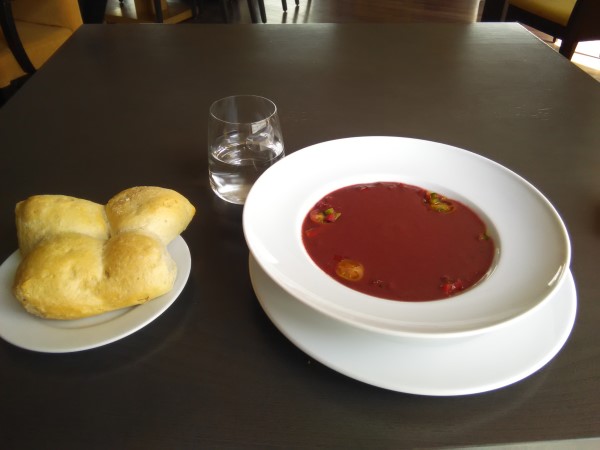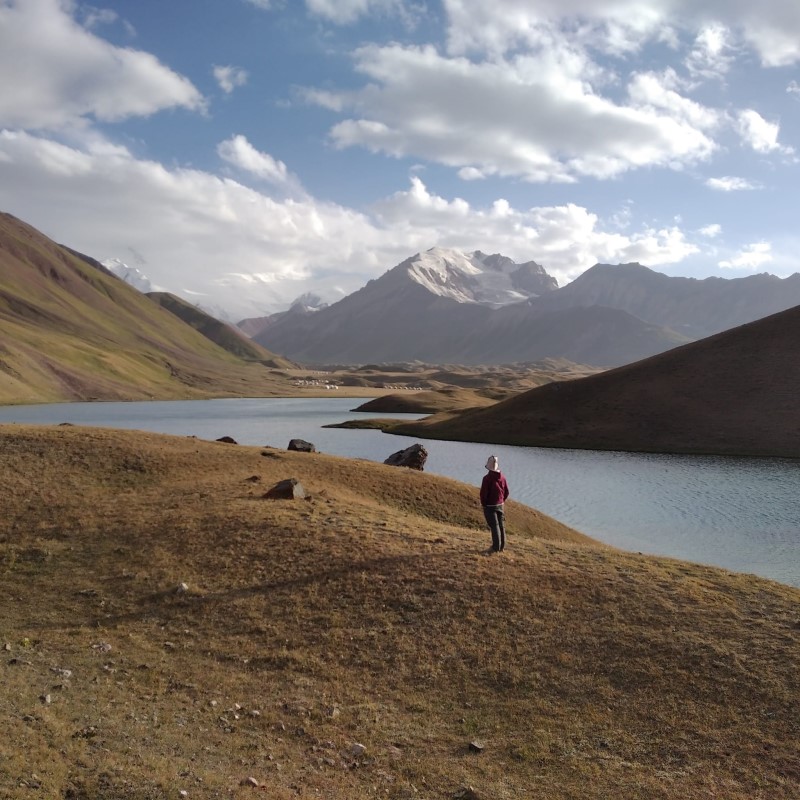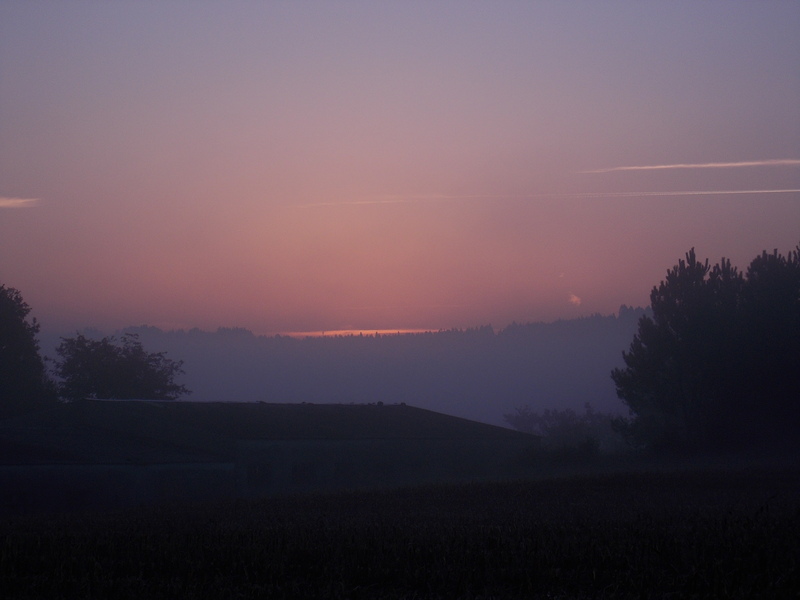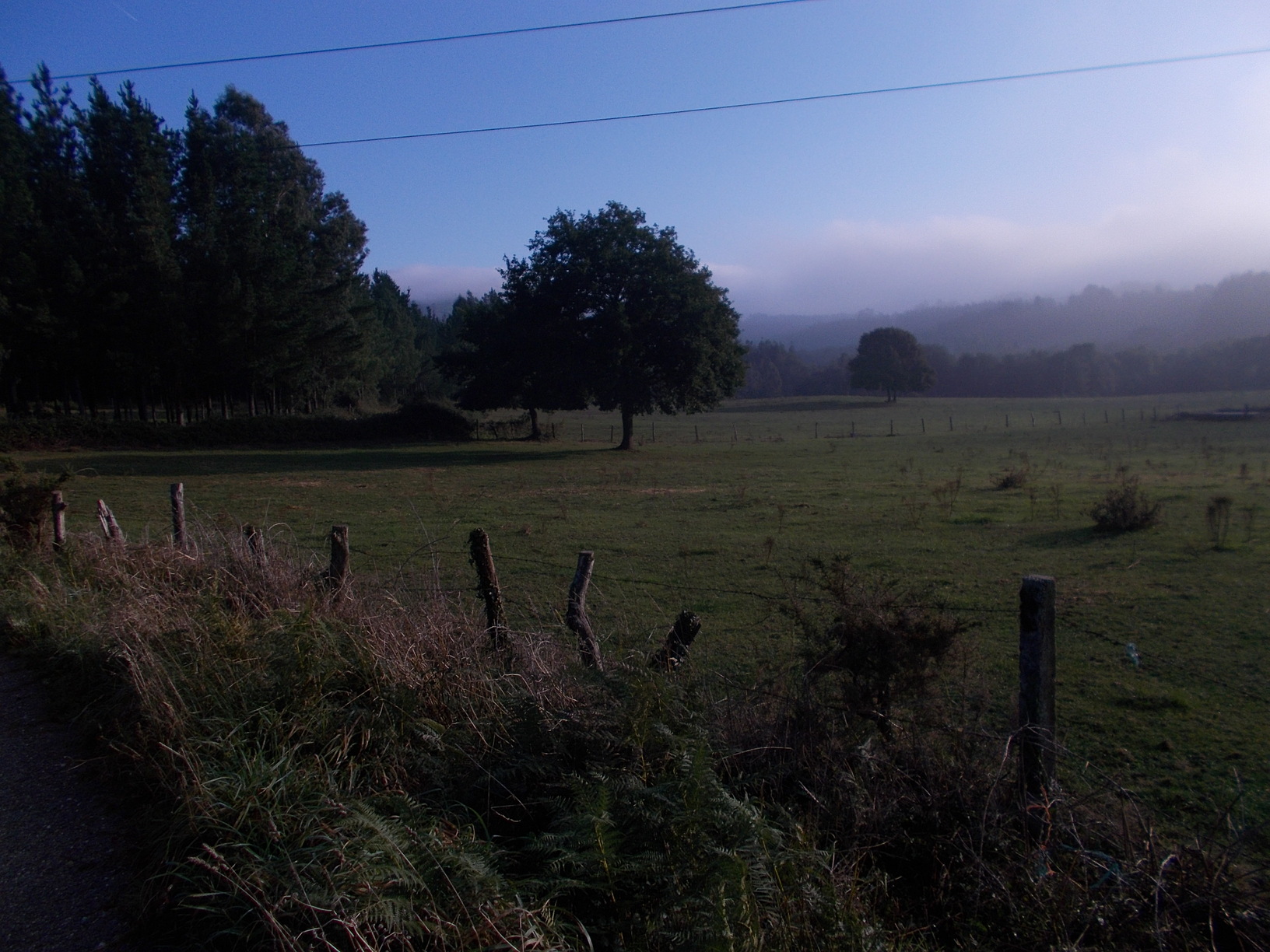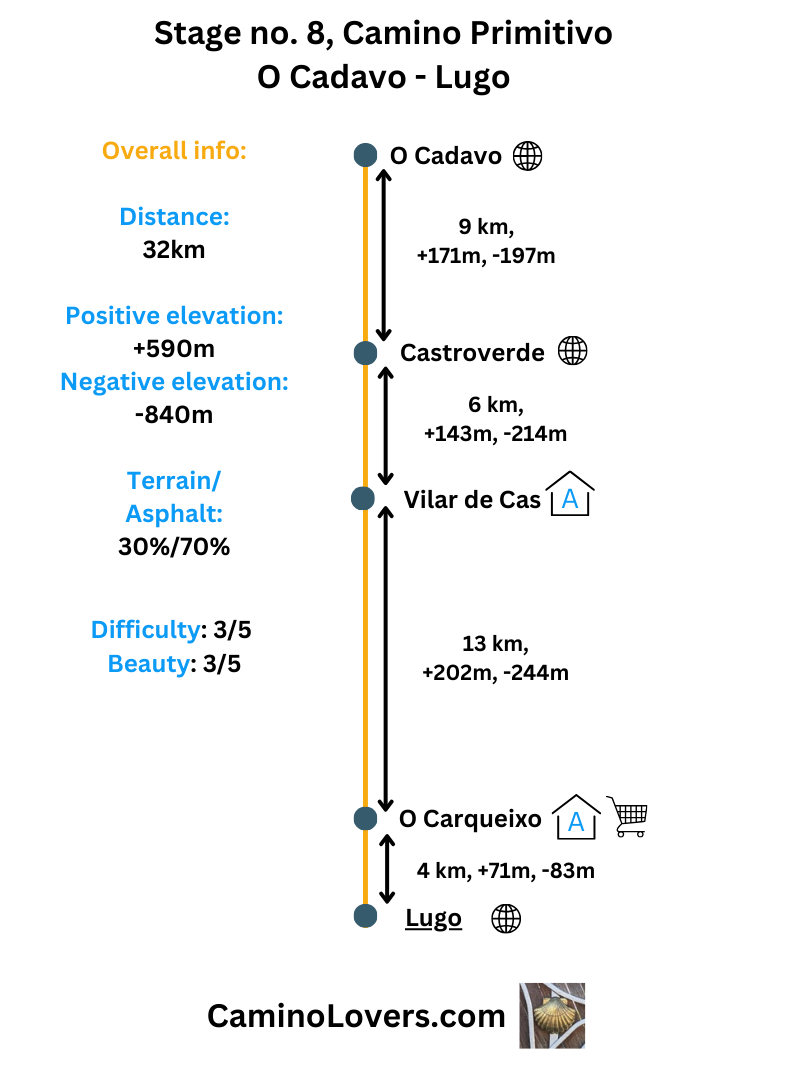
Basic Details
- Starting point: A small Galician town of O Cadavo, which lives basically from two things–animal husbandry and Camino de Santiago. All services for pilgrims, plenty of beds in the albergues.
- Ending point: Lugo, a beautiful Galician city of roughly 100,000 inhabitants, which happens to be the only city in the world to be surrounded by completely intact Roman walls. Many people consider Lugo more beautiful than Santiago de Compostela, and the Roman walls attract lot of tourists too. Anyway, it is a beautiful city with all services for pilgrims, and one pilgrim hostel with 44 beds. It sometimes isn’t enough, but if you do not get a bed in the pilgrim hostel, you have plenty of options in tourist hostels, pensions, hotels, and other accommodation types in the city.
- Availability of alternative routes: There is a small alternative route (on some pages about the Camino even considered an official route), which follows the provincial road LU-530 for some 6 kilometers, before it reconnects to the Camino. I have mapped this alternative for you here. However, this route is much uglier than the official Camino (since you walk on a busy road with cars), and it isn’t shorter either. The only “advantage” I can see is that you will save yourself some 25 vertical meters of climb–which is really insignificant considering you will climb 590 vertical meters on the entire stage. Hence I do not recommend taking this alternative in any circumstances. But I wanted to point it out, since there are yellow arrows, and it may confuse you.
- Distance: 32 km (download GPS here).
- Link to online map: Official camino route: here.
- Elevation difference: + 590m, -840m.
- Difficulty score: 3/5.
- Beauty score: 3/5.
- Terrain/asphalt: 30%/70%. Sadly we are back to mostly asphalt walking, and that will be the story all the way towards Santiago. Luckily the small local roads that Camino follows today have minimal traffic (only locals who live in the hamlets you will pass by use them), since almost all people drive on the LU-530 provincial road (which you will walk on for less than 1 kilometer in total today, so no worries of some collisions with cars :)).
- Next stage: Camino Primitivo, Stage no. 9, Lugo – Ferreira.
- Previous stage: Camino Primitivo, stage no. 7, A Fonsagrada – O Cadavo.
Elevation profile for the route
 – As you can see, while this is one of the longest stages on Camino Primitivo (according to our guide, because at the end of the day it is up to you to decide how to plan your walk, and where you will stay for each night), it isn’t a hard one. One climb at the beginning, ideal to help wake you up a bit in the morning, and then it’s all going down or flat, with occasional little hill here or there. The terrain isn’t technical either. That’s why the stage has difficulty of 3/5 only, even if it is over 30 kilometers long.
– As you can see, while this is one of the longest stages on Camino Primitivo (according to our guide, because at the end of the day it is up to you to decide how to plan your walk, and where you will stay for each night), it isn’t a hard one. One climb at the beginning, ideal to help wake you up a bit in the morning, and then it’s all going down or flat, with occasional little hill here or there. The terrain isn’t technical either. That’s why the stage has difficulty of 3/5 only, even if it is over 30 kilometers long.
Advanced info about the stage
- Trail marking: In general really good, the only problem is the center zone of Lugo, where, among countless other signs, and all the people and hundreds of stimuli for your senses, it is easy to overlook the occasional yellow arrow or scallop shell. The town center is incredibly beautiful, but the streets aren’t organized in a regular way. And it is easy to get lost :). Hence in the city I suggest you to take your phone with you. Other than that you should be fine.
- Natural places worth seeing: Nothing worth a special mention to be honest. As it is always the case with bigger cities, the closer you get, the more urban the landscape becomes. Traffic intensifies, there is a production hall here and there, smoke, noise, you name it… But it isn’t entirely bad to be honest, and the town center of Lugo is super beautiful. If you seek green spaces withing the confines of city, the nicest park in town is Parque Rosalia de Castro, location on Google maps here. It is still just a park–so do not expect miracles, but it is well maintained, has nice flowers, different trees (some of them very old), statues, one water fountain.
- Historical, architectural, and culinary places worth seeing:
- Ermita da Virxe do Carme, really nice chapel from 17th century, right on the Camino, 5 kilometers from the starting point of today’s stage. Interesting architecture, covered porch (good for an emergency bivouac, or just resting in the rain), water fountain, even some picnic tables close to the chapel.
- Church of Santa Maria de Vilabade, right on the Camino, 7 km from the start, location on Google maps here. A Gothic church from 15th century, well preserved both outside and inside, locals often call it “The cathedral of Castroverde” , for in its beauty and architecture it easily matches many famous cathedrals in Spain. Definitely worth a stop and a visit, but the opening hours are rather short: from 8am to 11am, Tuesday to Sunday. They celebrate only one mass here, every month the second Sunday of the month, at 11am.
- The railway viaduct A Chanca, nicely seen from the Camino, great for taking a picture, exact location here. A 150 years old railway bridge, definitely one of the landmarks of the city. Back in the day of its construction, it was a real masterwork of architecture.
- Old town of Lugo, with the cathedral, the intact Roman walls (the only city in the world to have such), and the charming architecture and beautiful balance of colors. The good news is that since the Roman walls are intact, you can make a circle there, roughly 2 kilometers, and simply marvel at the beauty of this Galician city. If you aren’t unlucky with weather, I guarantee you that visiting the old town of Lugo and walking on the top of the Roman walls will be one of the highlights of your Camino Primitivo.
- Camping/bivouac options on this stage: Not a camping-friendly stage at all. You will find some churches and chapels, in the first half of the way, that will serve for a bivouac, for example the Ermita da Virxe do Carme, location on Google maps here, since it is in a peaceful spot, have a covered porch, a water fountain, and basically offers everything you may need for a bivouac on the Camino… The closer to Lugo you get, however, the more difficult it is to locate any half-decent spot to pitch a tent or to bivouac safely for the night. If you are in a desperate need to camp, for example since you run low on money and cannot offer a night in the hostel, you can try two green zones outside of Lugo (you pass through the city and continue a bit on to reach them). Based on what I’ve heard from another pilgrim, and also according to the mapping details, you may have some luck on the following two places: here (500 meters detour from the Camino), and here (2.5 kilometers detour from the Camino). While neither of these spots is very good, it will do for an emergency night in a tent close to Lugo. Both areas are forested, with many small paths, they aren’t private property so you can move freely and with a bit of luck find a decent spot to pitch a tent for the night… Keep in mind though that you are on the outskirts of a city with 100,000 inhabitants, which means that on any night some lovers, drug addicts, lunatics, hermits, or simply homeless people may venture to any of the green areas surrounding the city. What I try to say here is that if you prefer camping in calm, skip Lugo and its surroundings altogether.
- Dog friendly score: 2/5. The beginning isn’t bad, but once you get close to Lugo the stage isn’t really enjoyable for dogs, in any means. Little shade, lot of noise and traffic nearby, almost entirely road walking (with a bit of relief just before you enter the city), and then of course the big city life :). The only economical place which accept dogs in town is a hostel called Shiku, located here. But I have to warn you that it has a very bad reputation among pilgrims. Which only adds to the low score of this stage for anyone walking with a dog…
- Special remarks: While in reality the cathedral of Lugo is “only” 99 kilometers away from the cathedral in Santiago, the officials in the pilgrim office in Santiago de Compostela consider it over 100 kilometers away. Which means that if you start here, you will get The Compostela (the certificate of completing the pilgrimage of Saint James) upon reaching Santiago and going to the pilgrim’s office. It also means that many Spanish students, who get credits at school for completing a pilgrimage in summer, start their walk from here. Don’t be surprised with seeing new faces on the way and in the city. The way is also going to be a bit more crowded from now on…
My picks for accommodation on today’s stage
- Albergue A Pocina de Muniz, Vilar de Cas, km 15. Ideal if the stage is too long for you, or if simply want to have a short next day walking to Lugo, and one of the best rated albergues on entire Camino Primitivo, across all pilgrim platforms. Location and reviews on Google maps here. Beautiful location, amazing communal zones both inside and outside of the house, delicious communal dinner. 16 beds in dorm plus some private rooms, 20 euro/night for a dorm, check-in from noon. Recommended way of making a reservation: WhatsApp or phone call, +34 616 237 776, +34 628 298 805.
- Albergue Rectoral de Romeán, Romean, km 8 (1.4 km off the camino, the turn is clearly indicated). Location and reviews on Google maps here. A special place off the camino. Oasis of peace with massages, meditation, dinner with vegan/vegetarian options. 16 beds in 6 dorms, 18 euro/night, dinner is extra 20 euro. It is a bit on an expensive end, but it also isn’t a food you’d get in a typical local restaurant. Beautiful garden and simply a nice place to stay if you want to escape the crowds. Check-in from 2pm. Recommended way of making a reservation: Booking.com, here.
- Albergue Nazaret, Lugo, km 32. Location and reviews on Google maps here. A new albergue in Lugo (opened in 2024). Everything perfectly clean and well organized, ample communal spaces, you do not feel crowded there as it is often the case in albergues in bigger cities on the Camino, central location. 40 beds in 4 dorms, 15-22 euro/night, depending on the season and in which dorm you stay (some have lass beds some more). Check-in from 1pm. In my opinion the best pilgrim place in Lugo. Recommended way of making a reservation: Phone call or WhatsApp, +34 696 415 262.
- Four Rooms Hostel, Lugo, km 32. Location and reviews on Google maps here. A very cozy hostel with attention to detail, modern facilities, and perfectly equipped kitchen. Close to the 100km marker (in Lugo you have 100 kilometers left to reach Santiago). 16 beds in two dorms, plus some private rooms. Price from 24 euro/night, can go up depending on the season. It is a bit on an expensive end, but then you’re in Lugo, and this isn’t a typical hostel either :). Definitely the best choice if there are no beds left in Albergue Nazaret. Check-in from 13:30, recommended way of making a reservation: Booking.com, here.
Pictures from the stage
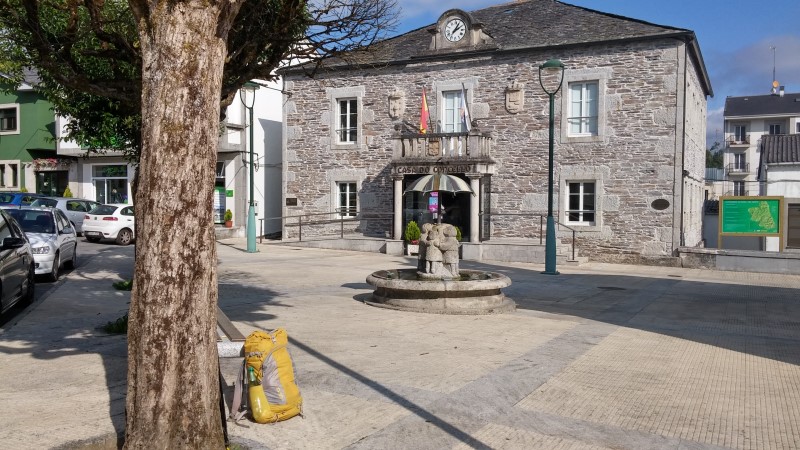 – Relaxing a bit in front of a town hall in Castroverde, km 9 of today’s walk. The yellow backpack on the ground is mine, the Golite brand, was famous back in the day, a great and super light backpack. Nowadays the brand does not exist anymore…
– Relaxing a bit in front of a town hall in Castroverde, km 9 of today’s walk. The yellow backpack on the ground is mine, the Golite brand, was famous back in the day, a great and super light backpack. Nowadays the brand does not exist anymore…
 – A famous railway viaduct on the outskirts of Lugo, called “A Chanca”. Exact location on Google maps here.
– A famous railway viaduct on the outskirts of Lugo, called “A Chanca”. Exact location on Google maps here.
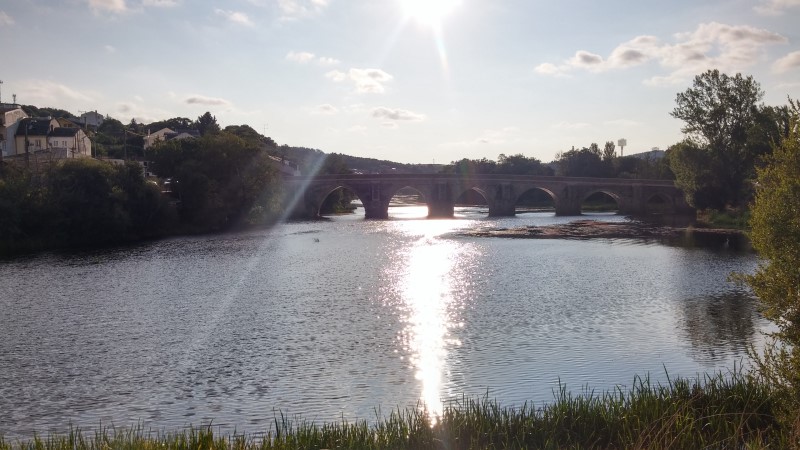 – Crossing the river while entering Lugo.
– Crossing the river while entering Lugo.
 – The Cathedral of Saint Mary of Lugo.
– The Cathedral of Saint Mary of Lugo.
 – The Roman walls of Lugo, ideal for a romantic walk in the evening ;).
– The Roman walls of Lugo, ideal for a romantic walk in the evening ;).
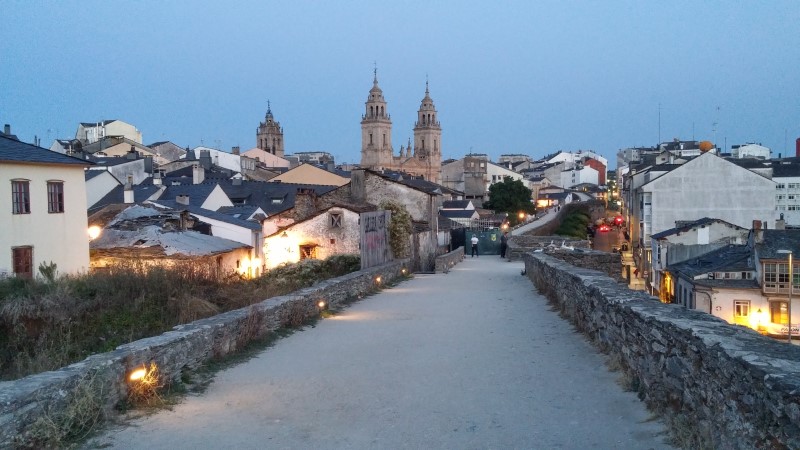 – Another picture from my evening walk on the Roman walls. As you can see, with the light and everything it is even more beautiful than during the day, and no doubt a no. 1 attraction of this touristic city.
– Another picture from my evening walk on the Roman walls. As you can see, with the light and everything it is even more beautiful than during the day, and no doubt a no. 1 attraction of this touristic city.
Few tips at the end
- A quick word to the hostels in Lugo: to put it mildly, they aren’t good… In contrary to smaller towns on Primitivo, that live mostly from the Camino and the money the pilgrims bring, Lugo is a touristic city, and except of a pilgrim albergue (which is a decent one, though not great in any means), the hostels aren’t a good environment for the pilgrims. Dirty, full of drunkards in the summer month, with lot of noise at night… What I try to say here is that if you do not get a bed in the municipal albergue in Lugo, perhaps this is the one night on your Camino when it is a good idea to get a room in a hotel. You can find affordable options in Lugo (below 30 euros/night), just check on Booking.com or your favorite hotel booking website.
Next/Previous Stage
- Next stage: Camino Primitivo, Stage no. 9, Lugo – Ferreira.
- Previous stage: Camino Primitivo, stage no. 7, A Fonsagrada – O Cadavo.



![Ultralight Packing List for Camino de Santiago [2025 Edition]](https://caminolovers.com/wp-content/uploads/2022/03/altra-shoes-640-x-480.jpg)
